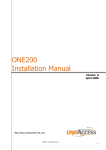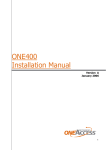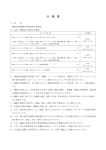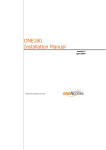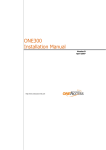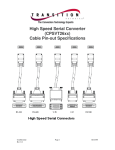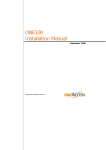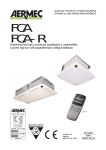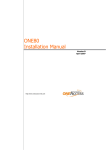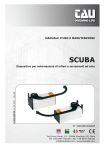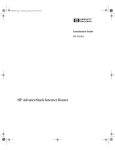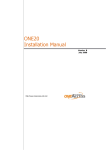Download ONE60 Installation Manual
Transcript
ONE60 Installation Manual Version A April 2005 http://www.oneaccess-net.com ONE60 – Installation Manual Page 1 OneAccess 28 rue de la Redoute 92260 Fontenay aux Roses France The law of 11 March 1957, paragraphs 2 and 3 of article 41, only authorizes, firstly, ’copies and reproductions strictly reserved for use by copyists and not for general use and, secondly, analyses and short quotations for the purpose of example and illustration. Therefore, ’any representation or reproduction, entire or partial, made without the consent of the author or his representatives is illegal’ (paragraph 1 of article 40). Any such representation or reproduction, made in any manner whatsoever, would therefore constitute an infringement of the law as sanctioned by articles 425 and in accordance with the penal code. Information contained in this document is subject to change without prior notice and does not constitute any form of obligation on the part of OneAccess. OneAccess and the distributors can in no case be held responsible for direct or indirect damage of any kind incurred as a result of any error in the software or guide. Every care has been taken to ensure the exactitude of information in this manual. If however you discover an error, please contact OneAccess After Sales Service division. April 2005 Issue 1000 00 N 4022 844 C 00 ind. B Page 2 ONE60 – Installation Manual How to Read this Manual The present document is broken down into 7 chapters. Chapter 1 – Safety Instructions This chapter provides the safety instructions for use and installation of the router. Chapter 2 – Directives and Standards This chapter details the list of standards, which the device complies with. Chapter 3 – Router Description This section describes the router front and rear panels and the associated technical characteristics. Chapter 4 – Interface Description This section describes the router interfaces. Chapter 5 – Technical Characteristics This section describes technical characteristics such as operating conditions. Chapter 6 - Installation This chapter describes how to mount a daughter-board and gives instructions to connect the router. Chapter 7 – Power-up This chapter describes the device power-up and how to monitor the self-test progress. Appendix – Connection description These chapters provide the pin-out of cables that are compatible with the router. ONE60 – Installation Manual Page 3 Table of Contents 1.1 1.2 1.3 SAFETY INSTRUCTION ..............................................................................................................5 Connection to Power Supply ...................................................................................................5 Overcurrent Protection ............................................................................................................5 Safety Instruction.....................................................................................................................6 2.1 2.2 2.3 DIRECTIVES AND STANDARDS................................................................................................7 Declaration of Conformity........................................................................................................7 Standards ................................................................................................................................8 FCC Statement (USA) .............................................................................................................9 3.1 3.2 3.3 3.4 3.5 ROUTER DESCRIPTION ...........................................................................................................10 Hardware Description............................................................................................................10 Front Panel ............................................................................................................................11 Rear Panel ............................................................................................................................12 Mother Board.........................................................................................................................13 Configuration Identification....................................................................................................14 1 2 3 4 INTERFACE DESCRIPTION......................................................................................................15 4.1 LAN Interface 10/100 Mbps (100 BT)....................................................................................15 4.2 Serial Interface (Vxx) .............................................................................................................16 4.3 Debug Interface (CONSOLE)................................................................................................17 4.4 ADSL Interface (UPLINK)......................................................................................................18 4.5 G.SHDSL/SDSL Interface (UPLINK).....................................................................................19 4.6 E1/T1 Interface (UPLINK) .....................................................................................................20 4.7 Ethernet Switch Interface (SWITCH).....................................................................................21 4.8 S0 Interface (ISDN) ...............................................................................................................22 4.9 PSTN Modem Interface (PSTN) ............................................................................................23 4.10 RS 232 Interface (RS 232) ....................................................................................................24 5 5.1 5.2 5.3 TECHNICAL CHARACTERISTICS............................................................................................25 Climatic Environment ............................................................................................................25 Power Supply ........................................................................................................................25 Dimensions............................................................................................................................25 6.1 6.2 6.3 INSTALLATION .........................................................................................................................26 Opening the Chassis .............................................................................................................26 Extension Board ....................................................................................................................27 Connections ..........................................................................................................................28 6 7 POWER UP ................................................................................................................................29 APPENDIX A - SERIAL INTERFACE CORDS.....................................................................................30 APPENDIX B - CONSOLE CORD .......................................................................................................38 APPENDIX C - INTERFACE RS 232 CORD .......................................................................................39 Page 4 ONE60 – Installation Manual 1 Safety instruction The following symbol instructs the user to consult the manual before any connection: 1.1 Connection to Power Supply To connect the power supply, always follow these steps: Connect the DC input jack from the power supply to the DC 5V power input on the rear panel of the router. Connect the power supply to an AC electrical outlet (100-240 VAC). Plugging in the power supply turns on the router Unplug the AC input before mounting/unmounting any part on the router. The AC input is the part you must disconnect first. For safety reasons, you shall be able to easily access this part. 1.2 Overcurrent Protection The product requires that the building’s electrical installation is designed for protection against short-circuit (over current) protection. A fuse or circuit breaker no larger than 240 VAC, 10A must be used on the phase conductors. ONE60 – Installation Manual Page 5 1.3 Safety Instruction The add-on modules and daughter boards must be installed only in the products authorized by OneAccess and only by qualified personnel as recommended in the installation manual. 1.3.1 LAN Interface 100 Mbps (100BT) The Ethernet 10/100 Mbps auto-sense has a ’SELV’ (Safety Extra Low Voltage) interface. They must be used only for indoor applications, connected to a 10/100 Mbps interface, which has also the ’SELV’ characteristics. 1.3.2 Serial Interface (Vxx) The router has a serial line interface supporting V.11, V.28, V.35 or V.36, which is ’SELV’. It must be used only for indoor applications and connected to V.11, V.28, V.35 or V.36 interfaces which are also designed as ’SELV’. 1.3.3 ADSL/SDSL/G.SHDSL Interface (UPLINK) The router has an ADSL/SDSL/G.SHDSL interface (TNV-1 type (Telephone Network Voltage)), designed for connection to a telephone line. 1.3.4 E1/T1 Interface ( UPLINK) This interface is ’TNV-1’. 1.3.5 ISDN S0 Backup Interface (ISDN) This interface is ’TNV-1’. It must be only connected to an ISDN S0 interface. 1.3.6 PSTN Modem Interface (PSTN) The analog MODEM interface V.32(bis)/V.34/V.90/V.92 is ’TNV-1’. It must be connected to a standard telephone line. 1.3.7 RS-232 Interface (RS 232) The daughter board provides 2 x RS 232 interfaces, which are ’SELV’. They must be used only for indoor applications and connected to RS 232 interfaces which are also designed as ’SELV’. Page 6 ONE60 – Installation Manual 2 Directives and Standards 2.1 Declaration of Conformity ONE60 – Installation Manual Page 7 2.2 Standards The ONE 60 is designed in conformity with the standards listed hereafter, provided that the basic housing, modules, interface boards and installation kits are mounted as recommended in the corresponding installation manual(s). Safety EN60950 (2000) Safety of information technology equipment, including electrical business equipment. Environment : Climatic, physico chemical, mechanic, packing ETS 300 019-1 (95) Environmental conditions and environmental testing for telecommunication equipment In use : Temperature Controlled Test specification : Part 1, Classification of environmental conditions - class T3.1 (normal) - class T3.1 (exceptionnal) Storage: partly temperature controlled T1.1 Part 2, Specification of environmental test Transportation: careful Transportation T2.3 Electromagnetic Compatibility, immunity EN 55024 Information technology equipment immunity characteristics. Limits and methods of measurement. EN 55022 class B (98) Limits and methods of measurement of radio interference characteristics of information technology equipment . FCC part 15 class B Federal Communication Commission regulation (USA). EN 300386 V.1.3.1 (2001) EMC Requirements Page 8 ONE60 – Installation Manual 2.3 FCC Statement (USA) The United States Federal Communications Commission (in 47 CFR 15.105) has specified that the following notice be brought to the attention of users of this product: This device has been tested and found to comply with the limits for a Class B digital device, pursuant to part 15 of the FCC Rules. These limits are designed to provide reasonable protection against harmful interference in a residential installation. This device generates, uses and can radiate radio frequency energy and, if not installed and used in accordance with the instructions, may cause harmful interference to radio communications. However, there is no guarantee that interference will not occur in a particular installation. If this device does cause harmful interference to radio or television reception, which can be determined by turning the device off and on, the user is encouraged to try to correct the interference's by one or more of the following measures: • • • Reorient or relocate the receiving antenna. Increase the separation between the device and the receiver. Connect the device into an outlet on a circuit different from that to which the receiver is connected. • Consult the dealer or an experienced radio/TV technician for help. The user may find the following booklet, prepared by the Federal Communications Commission, helpful: How to Identify and Resolve Radio/TV Interference Problems. This booklet is available from the U.S. Government Printing Office, Washington, D.C. 20402, Stock No. 004-000-00345-4. Use of a shielded cable is required to comply within Class B limits of Part 15 of FCC Rules. Pursuant to Part 15.21 of the FCC Rules, any changes or modifications to this device not expressly approved by OneAccess may cause, harmful interference and void the FCC authorization to operate this device. ONE60 – Installation Manual Page 9 3 Router Description 3.1 Hardware Description The ONE 60 is a powerful router delivering advanced IP services and management features. Compact and modular, the router can be equipped with an extensive set of interfaces. In addition to its router functions, the product also provides interworking functions such FRF.5, FRF.8, X.25 over TCP/IP (XOT) and PAD over XOT. The basic ONE 60 configuration is equipped with (the bolded keywords in parentheses indicate the keywords printed on the router back panel): • • • 1 serial port for Configuration and Debug (CONSOLE), 1 LAN access 10/100 Mbps (100BT), 1 Uplink access: E1/T1 or ADSL or G.SHDSL (2 or 4 wires) or SDSL (UPLINK). • The following functions/interfaces can be optionally offered: • 1 Serial access V.28/V.11/V.35/V.36, in DTE or DCE mode, with auto detection of the electrical layer (Vxx), 1 ’IPSEC’ encryption accelerator, 1 managed switch with 5 ports (SWITCH). • • • The addition of a daughter board enables the installation of one of the following functions: • 1 S0 ISDN Backup (ISDN), • 1 Modem access (V.32, V.32bis, V.34, V.90, V.92) (PSTN), • 2 RS 232 accesses V.28 (RS 232. • The different combinations are defined when ordering the router. Page 10 ONE60 – Installation Manual 3.2 Front Panel The front panel is provided with LEDS, which inform about the status of several router functions. Figure 2. Front panel LED OFF Green Red Status Switched Off Switched On & Operational Switched On & Not operational Reboot in progress Uplink Not used Synchronized Loss of synchronization Synchronization in progress IP Not used All IP Interfaces are up All IP interfaces are down Aux Not used Interworking function is operational (FRF, CES) Failure on Data Service ONE60 – Installation Manual Orange Blinking Green One IP Interface is not up (Connection failure on the LAN or WAN) Page 11 3.3 Rear Panel All the connectors are located on the rear panel: • • • • • • • • Figure 3. Input for the external power supply connector (DC input jack, 5V1,8A), Configuration and Debug port (RJ45) (CONSOLE), 1 Serial access port (MDR36 connector) (VXX), 1 xDSL or E1 access port (RJ45) (UPLINK), 1 LAN access 10/100 Mbps port (RJ45) (100BT), 1 S0 Backup access (RJ45) (ISDN) or, 1 Modem access (RJ11) (PSTN) and/or 2 x RS 232 access ports (RJ45) (RS 232), 5 port Ethernet switch (RJ45) (SWITCH). Rear panel equipped with a modem/RS 232 daughter board Depending on the ordered configuration of the system, the rear panel may vary. Page 12 ONE60 – Installation Manual 3.4 Mother Board The mother board provides: • • • • • Console port, 1 Fast Ethernet 10/100 Mbps, LEDs, Slot of the Uplink daughter board, Slot for S0 back up, PSTN modem and 2 x RS 232 daughter boards. Figure 4. Top view of the ONE60 mother board Depending on the ordered configuration of the system, the mother board may vary. ONE60 – Installation Manual Page 13 3.5 Configuration Identification The different device configurations are identified by adding one or several letters to the device denomination and printed on the labeling sticker glued on the bottom of the router. Options codification: • G: G.SHDSL 2 wires access or SDSL • D: G.SHDSL 4 wires access • A: ADSL access, 2 possible versions: • ADSL 50-AC : ADSL board Annex A • ADSL 50-AC : ADSL board Annex B and B-DT with “dying gasp” function • P: (for PRI) E1/T1 Uplink access • V: (V.xx) serial interface supporting V.11/V.35/V.28/V.36 • S: (Security) IPSEC encryption accelerator • E: Ethernet Switch function • B: S0 Backup or Modem/RS 232 function supported. Example: ONE60GE is a ONE60 router equipped with: • 1 G.SHDSL 2 wires access, • Ethernet Switch function. Page 14 ONE60 – Installation Manual 4 Interface Description 4.1 LAN Interface 10/100 Mbps (100 BT) 4.1.1 Characteristics • • • 4.1.2 10/100 Mbits/s, Half or full duplex, Auto-negotiation. Meaning of LED Colors Lit green led Blinking yellow Led 4.1.3 Link active Traffic in progress Connector Pinout RJ45 Connector: 4.1.4 Pin Signal Pin 1 TD (+) 5 Signal 2 TD (-) 6 RD (-) 3 RD (+) 7 NC 4 NC 8 NC NC Cables A standard Ethernet cable is needed (shielded UTP Cat. 5). ONE60 – Installation Manual Page 15 4.2 Serial Interface (Vxx) 4.2.1 Characteristics • • • • 4.2.2 Interface: RS 232, V.36, X.24, V.35, RS 449, EIA530, RIA530-A, DCE and DTE mode, Clock mode: contra-directional et co-directional, Automatic configuration of the characteristics of the serial port thanks to the signature of the cable connected. Cables The type of cable used on the serial line must correspond to the parameters provided in the router configuration. The installation of a cable on the serial line sets the interface mode (DTE or DCE) and type (V.11 or V.28 or V.35 or V.36). The automatic detection of the type of the used cable for the serial interface is performed when the device is powered up. It is mandatory to connect both sides of the serial interface (Vxx) cable before powering up the router. All serial cables are defined in Appendix A. Page 16 ONE60 – Installation Manual 4.3 4.3.1 Debug Interface (CONSOLE) Characteristics • • • 4.3.2 RS 232, 9,600 bps, 8 bits, 1 bit for stop, no parity. Connector Pinout RJ45 Connector: Pin 1 4.3.3 Signal Pin Signal TX 5 NC 2 RX 6 NC 3 GND 7 NC 4 NC 8 NC Cables The console cable is defined in Appendix B. ONE60 – Installation Manual Page 17 4.4 ADSL Interface (UPLINK) 4.4.1 Characteristics • • • • 4.4.2 ANSI T1.413 issue 2, ITU G.992.1 (Gdmt Annex A, B et C), ITU G.992.2 (Glit), Dying gasp (on ADSL Appendix B). Connector Pinout RJ45 Connector: Pin 4.4.3 Signal Pin Signal 1 NC 5 RING 2 NC 6 NC 3 NC 7 NC 4 TIP 8 NC Cables The cable of connection to the ADSL must be made using a standard telephone cable. Page 18 ONE60 – Installation Manual 4.5 4.5.1 G.SHDSL/SDSL Interface (UPLINK) Characteristics • • • • • 4.5.2 Line coding: 2B1Q or PAM, ATM-based, ETSI TS 101 135, ITU-T G.991.1, ANSI TR-28 for 2B1Q coding (single pair), • ITU-T G.991.2 for the G.SHDSL (Appendix A and B), 2 or 4 wires, • Throughput: SDSL 2B1Q: 144 kbps up to 2,320 kbps, SHDSL 2 wires: 192 kbps up to 2,320 kbps, SHDSL 4 wires: 384 kbps up to 4,640 kbps. Connector Pinout RJ45 Connector: Pin Signal Pin Signal 1 TIP (Line 2 / 4 wires) 5 RING (Line 1) 2 RING (Line 2 / 4 wires) 6 NC 3 NC 7 NC 4 TIP (Line 1) 8 NC Line 2 is intended for the optional G.SHDSL mode with 4 wires. 4.5.3 Cables The cable of the G.SHDSL interface must be carried out using a standard telephone cable according to the wiring described above. ONE60 – Installation Manual Page 19 4.6 E1/T1 Interface (UPLINK) 4.6.1 Characteristics • • • 4.6.2 E1 or T1, ANSI T1. 403 and FCC68, ITU-T I.431, G.703, G.736 (E1), G.823 (E1), G.704. Connector Pinout RJ45 Connector: 4.6.3 Pin Signal Pin Signal 1 RX (+) 5 TX (-) 2 RX (-) 6 NC 3 NC 7 NC 4 TX (+) 8 NC Cables The cord used for access E1/T1 is a shielded cord category 5, including 2 twisted pairs: emission (4-5) and reception (1-2). Page 20 ONE60 – Installation Manual 4.7 4.7.1 Ethernet Switch Interface (SWITCH) Characteristics The switch Ethernet function offers 4 ports Ethernet. Every port can be switched and/or routed. • • • • 4.7.2 10/100 Mbits/s, Half or full duplex, Auto-negotiation, Auto MDI/MDIX (detection whether the cable is crossed or not). Meaning of LED Colors Green LED Lit Blinking yellow LED 4.7.3 Link active Traffic in progress Connector Pinout RJ45 Connector: 4.7.4 Pin Signal Pin 1 TD (+) 5 Signal NC 2 TD (-) 6 RD (-) 3 RD (+) 7 NC 4 NC 8 NC Cables The cables are shielded, crossover/straight cables with 4 twisted pairs. The switch supports auto detection of crossover/straight cable (’auto-MDI/MDI-X detection’); the transmission pairs are (1-2) and receive pairs are (3-6). ONE60 – Installation Manual Page 21 4.8 S0 Interface (ISDN) 4.8.1 Characteristics The interface provides an ISDN access designed for data services. • • 4.8.2 TE Mode only, Full duplex, 2B + D channels compliant with ITU-T I.430. Meaning of LED Colors 2 LED indicate the interface status. Green LED Yellow LED 4.8.3 Off Level 1 deactivated On Level 1 activated Off No communication On Communication in progress Connector Pinout RJ45 Connector: Pin 4.8.4 Signal Pin Signal 1 NC 5 RX (-) 2 NC 6 TX (-) 3 TX (+) 7 NC 4 RX (+) 8 NC Cables The ISDN cord is an unshielded cable including 2 twisted pairs: emission (3-6) and reception pairs (4-5). Page 22 ONE60 – Installation Manual 4.9 4.9.1 PSTN Modem Interface (PSTN) Characteristics The router can be equipped with a daughter board delivering an access to the PSTN via an integrated analog modem. The modem has the following characteristics: • • 4.9.2 Compatible with V.32, V.32bis, V.34, V.90 and V.92, Compliant with TBR21. Connector Pinout RJ11 connector: Pin 4.9.3 Signal 1 NC 2 RING 3 TIP 4 NC Cables The cable is a standard telephone cord with one twisted pair. ONE60 – Installation Manual Page 23 4.10 RS 232 Interface (RS 232) 4.10.1 Characteristics An extension board allows to provide 2 x RS 232 access. • • • • 4.10.2 Synchronous mode: DCE or DTE mode is supported ( configuration with jumpers), Asynchronous Mode (115 kbits/s), Electrical Interface V.28, 8 signals managed : 102, 103, 104, 105 (RTS) , 106 , 108 (RTS), 109 (CD), 115. Connector Pinout RJ45 Connector: Pin Signal 1 4.10.3 Pin Signal 115 / RXC 5 103 / SD 2 105 / DPE 6 108 / ETDP 3 104 / RD 7 102 / GND 4 109 / DS 8 106 / PAE RS 232 Configuration Each RS 232 interface can be separately configured in DTE or DCE mode when using the synchronous mode: PORT 0 PORT 1 X3 DCE X2 1 1 DCE_DTE DCE_DTE X3 DTE X2 1 1 DCE_DTE DCE_DTE When using the asynchronous mode, the jumper connection is not relevant. 4.10.4 Cables The cable type must correspond to the desired more (DCE or DTE). All types of cord for RS 232 port are defined in Appendix C. Page 24 ONE60 – Installation Manual 5 Technical Characteristics 5.1 Climatic Environment Operating Environment: Temperature 0° C ≤ T ≤ 45°C Relative Humidity (HR) 5% ≤ HR ≤ 80% Absolute Humidity ≤ 24g / m3 Altitude ≤ 2500 m Storage Environment: 5.2 Temperature -25° C to 55°C Relative Humidity (HR) 5% ≤ HR ≤ 80% Absolute Humidity ≤ 24g / m3 Altitude ≤ 2500 m Power Supply • • 5.3 External Power Supply 100-240 VAC / 9W (5V - 1,8A). External Power Supply 48 VDC Dimensions The dimensions of the housing are: Width 215 mm Height 1U Depth 200 mm ONE60 – Installation Manual Page 25 6 Installation Always unplug the power cable before any hardware maintenance operation. This chapter describes mounting/unmounting operations for optional modules. The user should be aware that the router software auto-detects on-board modules and interfaces. All vacant slots of the rear panel must be obstructed with suitable faceplates in order to guarantee the respect of the EMC standards as defined in Chapter 2. Directives and Standard=s. 6.1 Opening the Chassis • • • By means of a Posidriv #1 screwdriver, unlock the screw without removing it, (half a turn should be sufficient for unlocking the screw). Make the screw slide to the left hand side (by following the arrow next to the ’Open’ mark) (1), Slide the cover from the front to back panel as indicated on the figure below. (2), Remove the cover (3). Figure 5. Page 26 Opening the chassis ONE60 – Installation Manual 6.2 Extension Board The installation or exchange of a daughter board requires opening the chassis. Figure 6. 6.2.1 Removal on an Extension Board • • • • 6.2.2 Removal-Installation of an Extension Board Unlock and remove the screws (a) of the module on the rear panel, Unlock and remove the screws (b) of the module printed circuit, Loosen the module from the motherboard connector by gently separating the motherboard and the module, Rise up the board. Installation on an Extension Board • • • • • • Remove the protective faceplate of the slot, Position the module so that the module metallic faceplate fits in the place made available by the removal of the faceplate, Lower the module while aligning the module with the motherboard connector, Plug the module into the motherboard connector, Tighten the screws (b) on the printed circuit, Tighten the screws (a) on the router rear panel. ONE60 – Installation Manual Page 27 6.3 Connections The external power supply is connected on the rear panel of the device. The external power supply is delivered with the router package. • • Connect the ’jack’ connector of the external power supply to the connector marked ’5V-1,8A’ device connector, Secure the power supply connection by installing the DC power supply cable into the plastic ring as indicated on the following figure. Figure 7. Connection of the DC Input Jack The device shall not be used with another power supply than a power supply recommended by OneAccess. Page 28 ONE60 – Installation Manual 7 Power up To power up the device, always follow these steps: • • Connect the DC power input jack from the power supply to the DC power input of the rear panel of the router, Connect the power supply to the AC mains (100-240 VAC). Few seconds after power-on, the device performs a series of self-tests and loads the software into memory (RAM), during which the ’STATUS’ LED on the front panel blinks. At the end of software loading (about 30 seconds): • • The ’STATUS’ LED light remains steady green if software initialization was successful, The ’STATUS’ LED remains blinking in case of software absence or error during software loading. Refer to the Software and ONEOS User Guide for more information. ONE60 – Installation Manual Page 29 Appendix A - Serial Interface Cords A1 V.24/V.28 DTE CABLE Pin Connection Table reference: 4 021 863 00 Ed A P1 P2 - P1 SIGNAL MDR 36 Pts Casing Screening 1 103 (SD) 2 113 (TXCE) 3 114 (TXC) 4 115 (RXC) 5 104 (RD) 6 7 105 (RTS) 8 108 (DTR) 9 10 109 (CD) 11 107 (DSR) 12 106 (CTS) 13 141 (LL) 14 142 (TM) 15 16 102 17 Ident0 18 Ident2* 19 20 21 22 23 24 25 26 27 28 29 30 31 125 (IA) 32 140 (RL) 33 34 102 35 Ident1* 36 Ident3 * signal looped to pin 34 for cable auto detection Page 30 ONE60 – Installation Manual - P2SUB-D 25 Pts male 1 + Casing 2 24 15 17 3 4 20 8 6 5 18 25 7 22 21 A.2 V.24/V.28 DCE CORD Catalog reference: 4 021 864 00 Ed A P1 P2 - P1 SIGNAL MDR 36 Pts Casing Screening 1 104 (RD) 2 115 (RXC) 3 114 (TXC) 4 113 (RXCE) 5 103 (SD) 6 7 106 (CTS) 8 107 (DSR) 9 10 109 (CD) 11 108 (DTR) 12 105 (RTS) 13 125 (IA) 14 140 (RL) 15 16 102 17 Ident0* 18 Ident2* 19 20 21 22 23 24 25 26 27 28 29 30 31 141 (LL) 32 142 (TM) 33 34 102 35 Ident1 36 Ident3 * signal looped to pin 34 for cable auto detection ONE60 – Installation Manual - P2SUB-D 25 Pts female 1 + Casing 3 17 15 24 2 5 6 8 20 4 22 21 7 18 25 Page 31 A.3 V.36 DTE CORD Catalog reference: 4 021 865 00 Ed A P1 P2 - P1 MDR 36 Pts Casing 1 2 3 4 5 6 7 8 9 10 11 12 13 14 15 16 17 18 19 20 21 22 23 24 25 26 27 28 29 30 31 32 33 34 35 36 Screening 103A (SD) 113A (TXCE) 114A (TXC) 115A (RXC) 104A (RD) - P2SUB-D 37 Pts male 1 + Casing 4 17 5 8 6 105A (RTS) 108A (DTR) 7 12 109A (CD) 107A (DSR) 106A (CTS) 141 (LL) 142 (TM) 102a 102 Ident0 Ident2* 103B (SD) 113B (TXCE) 114B (TXC) 115B (RXC) 104B (RD) 13 11 9 10 18 37 19 105B (RTS) 108B (DTR) 25 30 109B (CD) 107B (DSR) 106B (CTS) 125 (IA) 140 (RL) 102b 102 Ident1 Ident3 31 29 27 15 14 20 SIGNAL * signal looped to pin 34 for cable auto detection Page 32 ONE60 – Installation Manual 22 35 23 26 24 A.4 V.36 DCE CORD Catalog reference: 4 021 866 00 Ed A P1 P2 - P1 MDR 36 Pts Casing 1 2 3 4 5 6 7 8 9 10 11 12 13 14 15 16 17 18 19 20 21 22 23 24 25 26 27 28 29 30 31 32 33 34 35 36 Screening 104A (RD) 115A (RXC) 114A (TXC) 113A (TXCE) 103A (SD) - P2SUB-D 37 Pts female 1 + Casing 6 8 5 17 4 106A (CTS) 107A (DSR) 9 11 109A (CD) 108A (DTR) 105A (RTS) 125 (IA) 140 (RL) 102b 102 Ident0* Ident2 104B (RD) 115B (RXC) 114B (TXC) 113B (TXCE) 103B (SD) 13 12 7 15 14 20 19 106B (CTS) 107B (DSR) 27 29 109B (CD) 108B (DTR) 105B (RTS) 141 (LL) 142 (TM) 102a 102 Ident1* Ident3 31 30 25 10 18 37 SIGNAL 24 26 23 35 22 * signal looped to pin 34 for cable auto detection ONE60 – Installation Manual Page 33 A.5 X.21/V.11 DTE CORD Catalog reference: 4 021 867 00 Ed A P1 P2 - P1 MDR 36 Pts Casing 1 2 3 4 5 6 7 8 9 10 11 12 13 14 15 16 17 18 19 20 21 22 23 24 25 26 27 28 29 30 31 32 33 34 35 36 SIGNAL - P2SUB-D 15 Pts male Screening 103 (TA) 113 (XA) 1 + Casing 2 7 115 (SA) 104 (RA) 6 4 105 (CA) 3 109 (IA) 5 102 Ident0 Ident2 103 (TB) 113 (XB) 8 9 14 115 (SB) 104 (RB) 13 11 105 (CB) 10 109 (IB) 12 102 Ident1* Ident3 * signal looped to pin 34 for cable auto detection Page 34 ONE60 – Installation Manual A.6 X.21/V.11 DCE CORD Catalog reference: 4 021 868 00 Ed A P1 P2 - P1 MDR 36 Pts Casing 1 2 3 4 5 6 7 8 9 10 11 12 13 14 15 16 17 18 19 20 21 22 23 24 25 26 27 28 29 30 31 32 33 34 35 36 • SIGNAL - P2SUB-D 15 Pts female Screening 104 (RA) 115 (SA) 1 + Casing 4 6 113 (XA) 103 (TA) 7 2 109 (IA) 5 105 (CA) 3 102 Ident0* Ident2 104 (RB) 115 (SB) 8 11 13 113 (XB) 103 (TB) 14 9 109 (IB) 12 105 (CB) 10 102 Ident1 Ident3 signal looped to pin 34 for cable auto detection ONE60 – Installation Manual Page 35 A.7 V.35 DTE-1 mm CORD Catalog reference: 4 022 170 00 Ed A P1 P2 - P1 MDR 36 Pts Casing 1 2 3 4 5 6 7 8 9 10 11 12 13 14 15 16 17 18 19 20 21 22 23 24 25 26 27 28 29 30 31 32 33 34 35 36 SIGNAL - P2male connector Screening 103A (SD) 113A (TXCE) 114A (TXC) 115A (RXC) 104A (RD) A + Casing P U Y V R 105A (RTS) 108A (DTR) C H 109A (CD) 107A (DSR) 106A (CTS) 141 (LL) 142 (TM) F E D L NN 102 Ident0 Ident2* 103B (SD) 113B (TXCE) 114B (TXC) 115B (RXC) 104B (RD) B S W AA X T 125 (IA) 140 (RL) J N 102 Ident1 Ident3* *signal looped to pin 34 for cable auto detection Page 36 ONE60 – Installation Manual A.8 V.35 DCE-1 mm CORD Catalog reference: 4 022 171 00 Ed A P1 P2 - P1 MDR 36 Pts Casing 1 2 3 4 5 6 7 8 9 10 11 12 13 14 15 16 17 18 19 20 21 22 23 24 25 26 27 28 29 30 31 32 33 34 35 36 Screening 104A (RD) 115A (RXC) 114A (TXC) 113A (TXCE) 103A (SD) - P2female connector A + Casing R V Y U P 106A (CTS) 107A (DSR) D E 109A (CD) 108A (DTR) 105A (RTS) 125 (IA) 140 (RL) F H C J N 102 Ident0* Ident2 104A (RD) 115B (RXC) 114B (TXC) 113B (TXCE) 103B (SD) B T X AA W S 141 (LL) 142 (TM) L NN SIGNAL 102 Ident1* Ident3* * signal looped to pin 34 for cable auto detection ONE60 – Installation Manual Page 37 Appendix B - Console Cord Catalog reference: 4 022 332 B 00 Ed A P1 P2 RJ45 - P1 1 2 3 Page 38 SIGNAL TX RX GND ONE60 – Installation Manual To PC serial port in terminal mode (Configuration) SUB-D 9 Pts Female - P2 2 3 5 Appendix C - interface RS 232 Cord C-1. V.28 / RS 232 DTE CABLE Catalog reference : 4022 815 B 00 P1 P2 - P1 RJ45 SIGNAL 1 115 (RXC) 2 106 (CTS) 3 103 (SD) 4 5 108 (DTR) 104 (RD) 6 109 (CD) 7 102 8 Screening 105 (RTS) ONE60 – Installation Manual - P2 SUB-D 25 Pts male 17 5 2 20 3 8 7 4 Casing Page 39 C-2. V.28 / RS 232 DCE Cord Catalog reference: 9594 508 07146 P1 Page 40 P2 - P1 RJ45 SIGNAL 1 115 (RXC) 2 105 (RTS) 3 104 (RD) 4 109 (CD) 5 6 103 (SD) 108 (DTR) 7 102 8 Screening 106 (CTS) ONE60 – Installation Manual - P2 SUB-D 25 Pts female 17 4 3 8 2 20 7 5 Casing








































